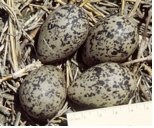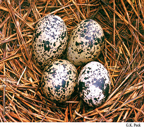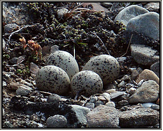Eggshell Removal in Shorebirds
Biology 342 Fall 06
By Molly & Jennifer
| Home | Mechanism | Ontogeny | Phylogeny | Adaptive Value | References | 2006 websites |
Introduction
In the 1960s ethologist Nikolaas Tinbergen published a paper entitled “On the Aims and Methods of Ethology,” and proposed a method studying animal behavior that has been adopted by modern behavioral researchers. In his paper he suggested that the four fundamental components of ethology involve studying the mechanism, ontogeny, evolution, and survival value of behaviors. In this same paper, Tinbergen mentioned a peculiar behavior he had observed that he later went on to study in great detail: eggshell removal in black-headed gulls. After chicks are born in gulls, and most other shorebirds, the parents will remove the eggshells from the nest and drop them some distance away. In his later work, Tinbergen proposed five hypotheses to explain the evolutionary advantage of this behavior:1) Sharp shell edges could injure newly hatched chicks
2) Unhatched eggs could be trapped inside hatched shells, thereby reducing the ability of other eggs to hatch
3) Hatched shells could interfere with brooding
4) Hatched shells could reduce nest hygiene and increase the risk of bacterial infection
5) Hatched shells could reduce nest camouflage, thereby increasing the risk of visually oriented predators.
Tinbergen devoted most of his efforts to investigating the fifth hypothesis, the role of eggshell removal in maintaining nest camouflage, but contemporary researchers have continued this line of investigation while considering the other four hypotheses as well. Current researchers have also noticed that many birds show a similar behavior, fecal sac removal. This behavior is similar to the eggshell removal behavior, and recently researchers have studied how fecal sac removal might have a similar survival value as eggshell removal (link to Kenneth Petit’s study). Most researchers agree that eggshell removal plays in important role in shielding the nest from predators, but there is controversy over whether eggshells left in the nest reduce the chances of individual survival for the other reasons, such as hygiene and egg-capping, outlined by Tinbergen.
Shorebirds are the main order of birds that show this behavior, and in addition to being closely related evolutionarily, also share a similar habitat and breeding strategy. Most shorebirds live in wetlands and build their nests on the ground, with little to no nesting material. They lay 2-4 eggs per breeding season and their eggs are very well camouflaged on the outside. It is only when these eggs hatch, exposing their white interior, that camouflage is reduced.
Shorebird eggs
There remain many unexplained components of the egg-removing behavior. Birds generally either remove the eggshells from their nests, or, if the birds have precocial young, abandon the nest and the eggshells with it. Both of these behaviors achieve the same end—distancing the chicks from the eggshells. However, some species of birds both remove the eggshells and abandon the nest shortly afterwards. Is this egg-removal behavior essentially “evolutionary baggage,” or does it increase the likelihood of a chick’s survival in the short period of time it is in the nest? How does this behavior develop? Does the risk of leaving the newborn chicks unprotected ever outweigh the benefits of removing eggshells from the nest? These are questions currently being investigated by researchers and are questions we will attempt to address on this site.


